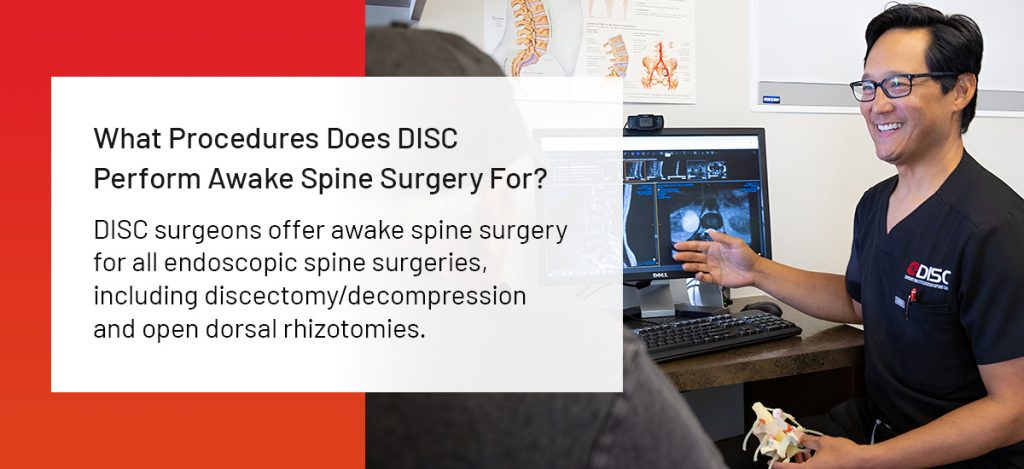
Having surgery while awake can sound a little odd, but in the field of spine surgery, it’s been happening for a few decades now. This unique method of surgery offers some exceptional benefits, helping people enjoy less recovery time and supporting surgeons in more accurate, safer procedures. Let’s explore awake spine surgery and how to find out if it’s right for you.
Awake spine surgery, also called conscious intravenous (IV) sedation surgery, typically refers to a surgical procedure where the patient remains awake and alert during the operation. Conscious sedation is generally administered through IV medications, and the dosage can be adjusted to keep the patient comfortable and relaxed throughout the procedure.
The goal of awake spine surgery with conscious sedation is to provide pain relief, reduce anxiety, and induce a state of calmness while still allowing the patient to breathe independently, respond to the surgeon’s questions, and report any symptoms during the surgery to help make the surgery safer.
General anesthesia is the gold standard for most minimally invasive spine surgeries. However, it puts a patient in a sleep-like state and has some risks and unappealing potential side effects in recovery. Some side effects are nausea, throat irritation from ventilation tubing, and brain fog. Patients undergoing general anesthesia may require a longer recovery process, with many requiring overnight observation, as the medications take about 24 hours to leave your system.
At DISC, our surgeons have offered awake spine surgery since the 1990s. We currently utilize conscious IV sedation for the following endoscopic surgeries: endoscopic discectomy/decompression and open dorsal rhizotomy. These advanced surgical procedures are called ultra-minimally invasive spine surgery (ultra MIS), which uses smaller incisions and can help improve surgical outcomes, quality of life after surgery, and patient satisfaction.
Unsurprisingly, many patients have questions about awake spine surgery. Here are a few common questions and answers on this procedure.
There are many benefits to awake spine surgery, including easier recovery and a shorter hospital stay, with most patients going home within two hours of surgery completion. Many patients who undergo awake spine surgery with conscious sedation have higher overall satisfaction after surgery. Here are a few benefits of awake spine surgery:

DISC surgeons offer awake spine surgery for all endoscopic spine surgeries, including discectomy/decompression and open dorsal rhizotomies. In fact, DISC has led the emerging field of awake spine surgery for over 30 years. Our surgeon team at DISC has performed over 15,000 awake spine surgeries.
Yes, awake spine surgery has been proven safe for patients undergoing endoscopic spine surgery. DISC has worked collaboratively with the anesthesiology team over the past 30 years, establishing safe and effective conscious sedation protocols that are highly beneficial to patient outcomes. The patients benefit from faster recovery, fewer postoperative complications, and discharge from the hospital sooner.
A significant benefit of awake spine surgery is its faster completion time. It reduces both operating and recovery time. In most cases, the procedure only takes an hour, and patients can go home the day of their surgery, rather than the one or two days usually required by traditional methods. After leaving, patients usually only need a few days to recover before resuming administrative work and recreational activities.
Awake spine surgery typically uses two kinds of anesthesia: local and conscious IV sedation. Local anesthesia numbs a specific part of the body, while conscious IV sedation puts you in a twilight state and helps block pain. If you’ve ever had a dental procedure, you may have received conscious IV sedation.
You likely won’t remember the experience, but you’ll be able to respond to the surgeon as needed. This conscious sedation makes you feel relaxed and calm. The medication wears off quickly, and you should become alert shortly after the operating team stops administering the sedative, but you might feel drowsy for the rest of the day.
Desert Institute for Spine Care has used awake spine surgery or conscious sedation for their endoscopic discectomy and open dorsal rhizotomy surgeries since the late 1980s. In fact, DISC surgeons were the first in the country to offer awake spine surgery in this emerging endoscopic group of surgical procedures called ultra-minimally invasive spine surgery.
Dr. Anthony Yeung developed the spinal endoscopic techniques called selective endoscopic discectomy and open dorsal rhizotomy. While the patient is mildly sedated, the surgeon can visualize the spinal anatomy and pain generators in high-resolution imaging and communicate with the patient during surgery to correlate the patient’s symptoms and selectively treat the painful spinal anatomy.
Some of our patients are nervous about awake spine surgery, which is understandable. However, once we explain the conscious sedation and surgical benefits, they typically move forward. After surgery, most patients report high satisfaction rates for the procedure.
If you have one of the conditions mentioned above, awake spine surgery could be an option. Some of the things we look for when considering awake spine surgery include:
Awake spine surgery can be especially useful if you don’t tolerate general anesthesia well.
Awake spine surgery can be a great option for many patients, reducing recovery time, saving costs, and improving accuracy. If you’re considering awake spine surgery, the industry leaders at DISC can help. Our team has been at the forefront of this procedure since its inception. We’ll walk you through the process and answer any questions.
Call us or request an appointment today to find out if awake spine surgery is a good fit for you!
